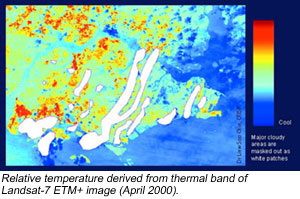|
by Wong Nyuk Hien

 he urban heat island (UHI) effect occurs when city temperatures run higher than those in suburban and rural areas, primarily because growing numbers of buildings have supplanted vegetation and trees. Moreover, human activity itself generates heat. he urban heat island (UHI) effect occurs when city temperatures run higher than those in suburban and rural areas, primarily because growing numbers of buildings have supplanted vegetation and trees. Moreover, human activity itself generates heat.
One possible solution to the UHI effect might lie in growing plants on rooftops and creating sky-rise gardens. A study by Singapore researchers found that such gardens reduce roof ambient temperature by 4°C and that heat transfer into the rooms below is lower. A study in Tokyo shows that if the temperature in Tokyo goes down by 0.8°C as a result of rooftop gardens, electric-bill savings equivalent to approximately S$1.6 million per day could be achieved.
Higher temperatures influence the city environment in two principal ways. One involves air quality - the increase in temperature and the presence of air pollutants result in the formation of smog, which damages the natural environment and jeopardises human health. The other has its focus on energy use - UHI leads to greater use of air conditioning, which directly affects buildings' energy consumption.
A multidisciplinary research team, led by Dr Wong Nyuk Hien at the Department of Building, National University of Singapore, initiated a study of the UHI effect in Singapore in December 2001. The research partners include the Building and Construction Authority (BCA), the Housing and Development Board (HDB), the Meteorological Services of Singapore, the National Parks Board, and NUS' Centre for Remote Imaging, Sensing and Processing (CRISP). BCA and NUS provide the funding.
Two major strategies to reduce the UHI effect exist. One introduces more green areas into the built environment, and the other involves choosing proper building materials. With regard to the first, plants serve to filter carbon dioxide and other toxins. With regard to the second, using light-coloured roofing material or reflective coatings lowers indoor and surrounding temperatures.
The team members analysed climatic data collected from various regions of Singapore and historical climatic data obtained from meteorological services. This analysis allows the identification of the urban effects on climate by comparing present env-ironmental conditions to earlier pre-urban conditions. Statistical tools can be applied to determine whether significant differences can be observed between the two.
Since images from outside the earth's atmosphere can offer time-synchronised temperature data over a whole area, researchers have widely used satellite information in the exploration of the UHI effect. Particularly useful are images of Singapore and the region for use in mapping out surface temperatures and identifying possible hot spots (see figure).
Ambient air temperature constitutes one effective index in the evaluation of the urban thermal environment. The team recorded temperature and relative humidity measurements at several places in two sessions: one during the day and the other in the night. The locations it selected represented the whole island - housing estates, commercial districts, industrial sites and green areas - and the measurements clearly showed that the UHI phenomenon is alive and well in Singapore.
The researchers found the commercial- and business-district areas to be hotter than the green areas by 2°C. An average temperature of 29.27°C was recorded in the major shopping precinct - the Orchard Road area - between 10 and 11 pm, whereas the area near the MacRitchie Reservoir showed an average temperature of 27.36°C. Other locations that showed higher temperatures (above 29°C) included Raffles Place, Outram Park, Clementi and Toa Payoh, which are densely populated areas. Places like Tuas, Kembangan and Paya Lebar also have temperatures above 29°C owing to the industrialisation there. Woodlands, Sembawang, Pasir Ris and Kranji recorded lower temperatures.
The team conducted mobile surveys in a car and recorded the temperature by means of sensors attached to the vehicle roof at night. The four routes identified for the mobile survey were the east route, the west route, the central route and another route mainly through the city area. A preliminary study has been conducted by traversing a route from the west to the east.
A wind tunnel provides a mechanical means of producing wind under controlled conditions to study air flow. The researchers used scale models in wind tunnels to study the ventilation characteristics of the miniature simulations. They found that the wind speed in urban areas drastically decreased in comparison with wind speed undisturbed by structures. Because it can alter wind direction, wind tunnel modelling contributes much to the study of UHI.
The investigators have several additional projects planned or under way. They plan to use computational fluid dynamics modelling to simulate the airflow in densely built areas with air-conditioning condensers and extract vents, as well as heat sources such as roofs, facades, roads and pavements. Also in the planning stage is a detailed study of street canyons to explore how they could possibly be arranged in such a deliberate pattern as to provide beneficial ventilation.
The controlled experiments aim to provide a complete database that will include plants' leaf-area index (LAI - an indication of foliage density), temperature, heat flow and any other environmental variables. With such a database, the researchers can evaluate the influence of plants in mitigating the UHI effect, correlate LAI with thermal protection, gauge soil moisture and thermal protection, and study the impact of different building materials and their colours.
For more information contact Dr Wong Nyuk Hien at bdgwnh@nus.edu.sg.
|



 he urban heat island (UHI) effect occurs when city temperatures run higher than those in suburban and rural areas, primarily because growing numbers of buildings have supplanted vegetation and trees. Moreover, human activity itself generates heat.
he urban heat island (UHI) effect occurs when city temperatures run higher than those in suburban and rural areas, primarily because growing numbers of buildings have supplanted vegetation and trees. Moreover, human activity itself generates heat.